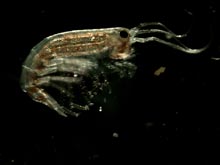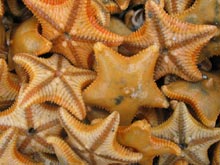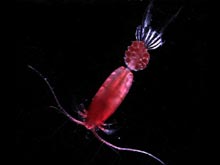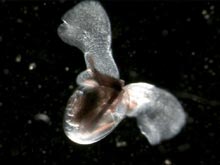
Under-ice amphipod Apherusa glacialis. Click image for larger view.
Life at the seafloor: Arctic sea star Ctenodiscus crispatus. Click image for larger view.
Arctic Biodiversity
Bodil Bluhm
Research Assistant Professor
School of Fisheries and Ocean Sciences
University of Alaska, Fairbanks
Russ Hopcroft
Associate Professor
Institute of Marine Science
University of Alaska, Fairbanks
What is biodiversity?
Biodiversity (or Biological diversity) refers to the variety of life forms
or living organisms; it can be measured in terms of genetic, species, ecosystem,
or landscape diversity. Our study will focus on species and ecosystem diversity,
although we will also be collecting samples for genetic diversity studies.
Why do we care about biodiversity in the Arctic?
Changes in global climate have the earliest and most pronounced effects in
high latitudes. Recent studies suggest a total loss in Arctic sea ice of 2-3%
per decade, with sea ice thickness being reduced an average of 1m in the Arctic
seas to the north and east of Alaska. Changes in oceanographic conditions such
as the warming of sea surface temperature, the depth of ocean mixing, and the
reduction of sea ice extent, will all have dramatic effects on the timing and
distribution of primary production, and therefore on the amount of food reaching
the sea-floor. Cascading effects to upper trophic levels (feeding position
in a food chain), such as marine mammals and sea birds, can also be expected.
Such effects can only be detected through long-term monitoring of ecosystems
and processes for which baseline data is essential.
Several large-scale, process-oriented investigations currently study some of the Arctic's continental shelf and slope environments, and their response to change. Processes are extremely important, but are critically impacted by the composition of biota (all the plant and animal life of a particular region) involved in them. Only the more obvious or abundant species are often targeted in such studies because they are believed to be more important in ecosystem function. Much of the diversity, however, is actually contributed by relatively rare species that are largely ignored because they are thought to be unimportant. By analogy, medical doctors are relatively rare in human communities, but their total absence would have grave consequences. Knowledge of such rare "species" in communities is, therefore, essential to discussions of climate change, in terms of its expressions on biological communities.
Consequently, there is a pressing urgency to obtain thorough
baseline information on the composition, diversity and functioning of Arctic
marine biological systems if we are to study the impact of climate changes.
Such assessment and understanding of biodiversity is a focus of both NOAA's
Office of Ocean Exploration and the Census of Marine Life's 'Arctic Ocean Diversity' (ArcOD) ![]() project. This cruise
represents a tremendous opportunity to continue our exploration of biodiversity
in one of the Arctic's least know regions, the deep Canada Basin.
project. This cruise
represents a tremendous opportunity to continue our exploration of biodiversity
in one of the Arctic's least know regions, the deep Canada Basin.
Where Arctic Life is From (Biogeography)
The Arctic is unique in its species origins because they represent four biogeographic
affinities: (1) Species that occur all over the Arctic and beyond, (2) Atlantic-origin
species, (3) Pacific-origin species, and (4) species only found in the Arctic
(endemics). The composition of these groups gives evidence about the geological
history of the Arctic.
Planktonic species, while partly endemic to the Arctic, are believed to be mostly derived from Atlantic origins rather than Pacific, despite considerable inflow of Pacific species through the Bering Strait. For sea floor species, most investigators agree on the diverse origin of today's Arctic fauna (animal life). The lack of Pacific-origin deep-water species is considered to be a consequence of the closing of the deep connection to the Pacific 80-100 million years ago, which never re-opened. The shallow inflow through the Bering Strait today allows migration of shallow-water Pacific species, but not deep-water species, into the Arctic Ocean. The opening of the Arctic towards the Atlantic 27-40 million years ago happened at the same time as a cooling phase, enhancing the development of a cool-temperate Atlantic-character fauna, along with a gradual 'Atlantization' of the Arctic Ocean.
This expedition contributes to the Arctic Ocean Diversity project (ArcOD) ![]() of the International Census of Marine Life
of the International Census of Marine Life ![]() .
.



































